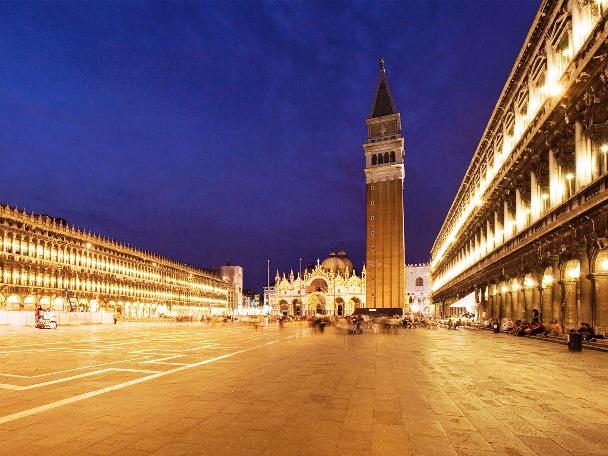San Marco in the heart of the city is Venice’s best-known area, one famous around the world. At the heart is the Piazza San Marco that Napoleon called “the world’s most beautiful drawing room.” Don’t be surprised that this is one of the most expensive neighborhoods in all Italy. Many buildings date back to the early Sixteenth Century. The original church that became the Basilica di San Marco was built in 828 to house the remains of Saint Mark the Evangelist.
About 150 years later it was virtually destroyed by fire. Its replacement was known as the Chiesa d’Oro (Golden Church), a monument to luxury, Venetian luxury. The building contains about an acre of spectacular mosaics, at their best in the midday light. The Pala d’Oro (altar screen) is covered with thousands of precious stones. For a different vision go to the top of the Campanile (Bell Tower), whose bells pealed at all important moments in this city’s history. Would you believe that the tower collapsed one night over a century ago without causing any deaths or damages?
Beautiful arcades called Le Procuratie, honoring the Procuratori of San Marco, number two in the Venetian pecking order after the Doge himself, surround the Piazza. After seeing the sights that include churches, museums, and palaces, or perhaps some fancy shopping relax in Venice’s oldest cafe, the world famous Caffe Florian, founded in 1720 or the Caffe Quadri in an arcade across the square.
Another popular (and of course pricey) choice is Harry’s Bar, an upstart that is still in its first century of operations.
The La Fenice district or, as they say in Venice, sestiere, occupying south-central Venice, the city’s most prestigious residential neighborhood, owes its name to the Teatro La Fenice, one of Italy’s oldest opera houses. This lovely edifice was inaugurated on 16 May 1792. It has been the site of many memorable operatic premieres, including the 1853 disastrous opening of Verdi’s La Traviata. We all know how well that worked out. This opera house was badly damaged by fire in January 1996 but has been meticulously restored. Very close by is the Campo San Stefano, once the site of Carnival feasts, balls and bull fights.
The Campo hosts two churches, the Eleventh Century Church of San Vidal, first rebuilt after a fire only twenty years after its initial construction and the Thirteenth Century Church of San Stefano whose vestry houses paintings by Tintoretto. In the nearby Campo Santa Maria del Giglio you will find the ancient Church of Santa Maria Zobenigo, initiated in the early Tenth Century and rebuilt hundreds of years later. This is one of the most beautiful Baroque buildings in all Venice.
The relatively small Palazzo Contarini del Bovolo was built in 1499. Bovolo is the Venetian word for a snail-shell. You’ll love its winding stairs, even though they are not attributed to the palace architect and may not be accessible to the public. The Palazzo Grassi on the Grand Canal dates back to the mid-Eighteenth Century. Unlike many other Venetian palaces, this joint had no ground floor merchant stalls. I guess the Grassis didn’t need the money. The Palazzo is now an art gallery boasting a 600-seat outdoor theater.
Only four bridges cross the Grand Canal. One is the Ponte dell’Accademia, first proposed in the mid-Fifteenth Century and then actually built a mere four centuries later. This steel bridge was subsquently replaced by a wooden one, even though I would have guessed vice versa. L’Accademia di Belle Arti di Venezia located south of the Grand Canal was founded in 1750 by the Venetian Senate to be Venice’s school of painting, sculpture, and architecture.
Its gallery displays the most extraordinary collection of Venetian art in the world, starting with Fourteenth Century works. Nearby you’ll find the Peggy Guggenheim Collection, Italy’s most important museum in Italy for European and American art of the first half of the Twentieth Century. Good old Peggy used to hang her hat here. The Sixteenth Century Palazzo Cini hosts the Collezione Cini, another great private art collection that became public.

